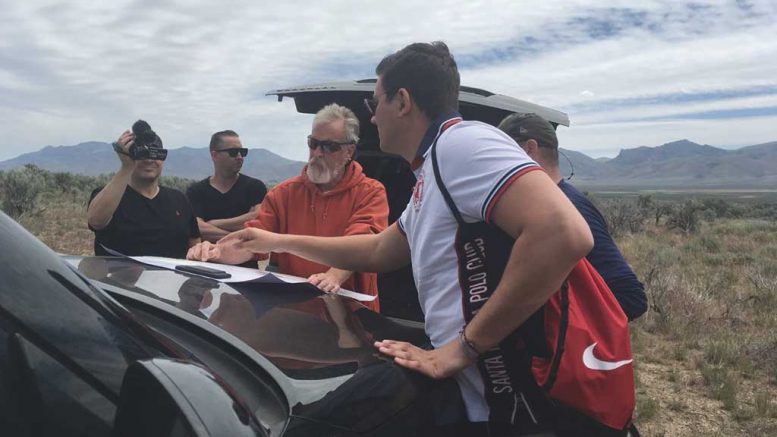In its fourth joint-venture deal in Nevada over the last six months, OceanaGold (TSX: OGC; ASX: OGC) will invest US$4 million for the next four years to earn a 51% stake in American Pacific Mining’s (CSE: USGD; US-OTC: USGDF) Tuscarora gold project.
OceanaGold’s other three joint ventures are with Bravada Gold (TSXV: BVA) on its Highland project in Nevada’s Walker Lake district, and with Renaissance Gold (TSXV: REN) at its Spring Peak project, also in Walker Lane, and its Fat Lizard project, in the Quinn Canyon Range of Nye County.
“Nearly 18 months ago, our executive vice-president of exploration, Craig Feebrey, set a strategy to target low-sulphidation epithermal projects in prolific gold districts, such as Nevada and Argentina,” Sam Pazuki, OceanaGold’s vice-president of investor relations, tells The Northern Miner. “In Nevada, we found that most gold companies had been focused on the large, Carlin-style mineralization, and almost neglected other types of geologies.”
The company saw this as an opportunity and looked at 30 projects, eventually selecting four partners for joint ventures. OceanaGold also holds equity stakes in two other Nevada-focused companies: Gold Standard Ventures (TSX: GSV; NYSE-AM: GSV) and NuLegacy Gold (TSXV: NUG).

American Pacific Mining president Eric Saderholm at the Tuscarora gold project, 50 km north of Elko, Nevada. Credit: American Pacific Mining.
OceanaGold owns a 15.6% equity position in Gold Standard, which is advancing its Railroad-Pinion project southeast in the Carlin trend of north-central Nevada. It holds a 16.2% stake in NuLegacy, which is working on its Redhill project in the state’s Cortez trend.
In its joint-venture deal with American Pacific Mining, OceanaGold notes that the junior’s early-stage Tuscarora project has geology that resembles that of its Waihi gold operation in New Zealand, where it recently added resources at its Martha underground project and made a discovery 10 km north called “WKP.”

A drill site at American Pacific Mining’s Tuscarora gold project in Nevada. Credit: American Pacific Mining.
“These low-sulphidation epithermal systems are typically smaller systems, but are high grade, and can be prolific,” Pazuki says, noting that WKP contains 234,000 oz. gold and 296,000 oz. silver in the East Graben vein within 0.41 million indicated tonnes grading 18 grams gold per tonne and 22.7 grams silver per tonne. Inferred resources in the East Graben and T-Stream veins add 401,000 oz. gold and 568,000 oz. silver within 1.05 million tonnes averaging 11.9 grams gold per tonne and 16.8 grams silver per tonne.
American Pacific Mining CEO Warwick Smith says he’s “thrilled.”
“It has been 10 months in the making to get it done, so we’re very pleased to have it over the line,” he says in an interview. “They said to us that they were looking for high-grade epithermal systems that are typically high cash-flow generators and high-margin ounces, and Tuscarora fit the bill for them.
“This deal is huge for us, it really moves the project forward,” he continues, noting that OceanaGold plans to spend US$625,000 on the project this year. The work will include a controlled source audio-frequency magnetotellurics (CSAMT) geophysical survey.
“They cracked the code at Waihi with CSAMT, and we believe they can do the same here at Tuscarora,” Smith says.
CSAMT is a resistivity surveying technique that puts an electric current into the ground at a location remote to where surveying takes place, and creates an electric field that measures resistivity variances at different depths, according to Lorrance Torckler, OceanaGold’s exploration manager at Waihi. It has been in use for 20–30 years — mostly for surveying horizontally layered formations — but at Waihi, OceanaGold has used it for subvertical veins, without live wires straddling the survey area. “This is the unique way we are using this technology, as many have started using it for subvertical surveys, but need live wires,” Torckler explains.

American Pacific Mining CEO Warwick Smith at a drill site on the Tuscarora gold property. Credit: American Pacific Mining.
Craig Feebrey, OceanaGold’s executive vice-president and head of exploration, notes that CSAMT has been effective at Waihi and earlier-stage exploration. “Geophysics including CSAMT can be effective in some geology while not effective in others, so time will tell in terms of our work in Nevada,” he says. “CSAMT is jut one exploration data set among many that we employ to define drill targets — drilling, as we know, being the ultimate test.”
American Pacific Mining’s shares closed down 10.7% — or 3¢ — at 25¢, on trading volume of 5.6 million shares. Over the last year the company’s shares have traded between 4¢ and 41¢.
The junior has 33 million shares for an $8.2-million market capitalization.
Tuscarora, 50 km northwest of Elko, sits at the foot of Mount Blitzen, 35 km northeast of the Carlin trend.
American Pacific Mining optioned the project in November 2017 from Novo Resources (TSXV: NVO; US-OTC: NSRPF) and has almost finished its earn-in, valued at $375,000 in cash and 800,000 of its common shares. It also has the option to buy Novo Resources’ 0.5% net smelter return royalty for $500,000.
The junior has drilled 16 holes in a 3,100-metre drill program of reverse-circulation and core drilling in the project’s South Navajo zone. Assays from the program include 18.40 grams gold over 2 metres starting at 201 metres downhole, and 16.06 grams gold over 3 metres from 198 metres downhole. The strike length of the South Navajo vein runs 1.6 km.
Drilling by Novo Resources and the project’s previous owner, Newcrest Mining (ASX: NCM), returned intercepts such as 2 metres of 368.31 grams gold within a 5-metre intercept of 127.08 grams gold, starting from 151 metres downhole, and 51.06 grams gold over 2 metres from 201 metres downhole.


Be the first to comment on "American Pacific signs JV with OceanaGold"